At forum, concerns raised about health impacts from large turbines
Experts say low-frequency infrasound has debilitating effects on about 10% of population who live near turbines
WILLIAMSVILLE – Wind turbines aren’t the noise-free, idyllic structures that are typically presented to be, said several speakers at a forum Tuesday on the public health impacts of industrial wind turbines.
The turbines, which tower more than 400 feet high, not only change the looks a rural landscape, but they have shadow flicker and infrasound that effect the health of many residents near the turbines.
Infrasound, in particular, is a very real problem, where low-frequency sound waves hurt disrupt the sleep and have debilitating effects on about 10 percent of the population, said Dr. Jerry Punch, a certified audiologist for over 50 years. He works at Michigan State University.
“I’m not saying everyone will get sick, but some will complain of health effects,” Punch told about 100 people Tuesday during the forum organized by State Sen. Robert Ortt at Erie Community College’s North Campus. “There is enough scientific evidence that infrasound causes annoyance and health effects. If not sited properly, the impacts would occur in substantial proportion of the population.”
Apex Clean Energy is working on projects in Barre and Yates-Somerset. Other wind energy developers have completed projects in Western New York, and Ortt said he expects more will be coming after the State Legislature and Gov. Andrew Cuomo passed the Climate Leadership and Community Protection Act, with a goal of achieving a carbon-neutral economy by 2050.
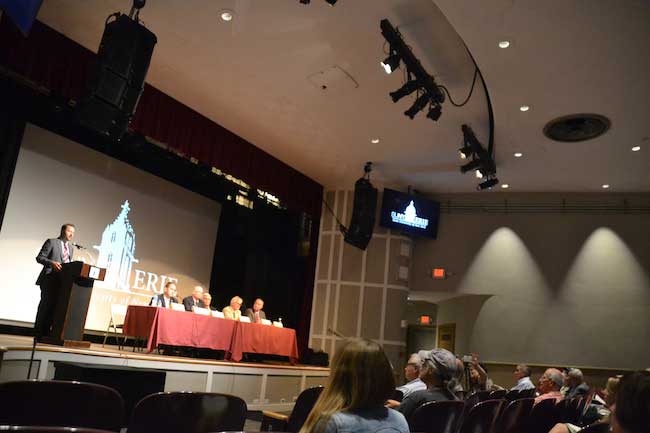
State Sen. Robert Ortt speaks during a forum Tuesday at Erie County Community College’s North Campus. He is joined by panelists, from left: Assemblyman Mike Norris, R-Lockport; Rob Rand, member of INCE (Institute of Noise Control Engineers); Jerry Punch, Ph.D., audiologist; Gary Abraham, an environmental attorney; and Dan Stapleton, Niagara County Commissioner of Health.
Ortt said the state will be pushing wind energy, solar and other renewable energy to meet those targets. Western New York and upstate will see more renewable energy projects because of the state’s carbon-neutral goals, Ortt said.
“If you live in a rural community you will see more of these kind of projects,” he told the crowd.
He said developers will likely pick poorer, rural communities.
“You don’t see turbines in affluent areas,” he said.
State officials need to consider the harm on some residents’ mental and physical health with siting projects, Ortt said.
“These are impacts we need to discuss because of the energy goals,” Ortt said. “We’re going to see more of these type of projects. At some point this will effect a lot of people not just in Western New York, but in Upstate New York.”
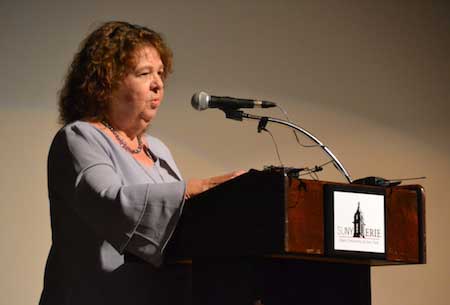
Linda Makson lives in Orangeville, Wyoming County, where Invenergy has had a turbine project since 2014.
Linda Makson of Orangeville said her house is surrounded by wind turbines.
“Every single window I look out I see one,” she said at the forum.
She and her husband Paul have lived in Orangeville since 1973. It was peaceful, but that changed with the turbine project, including during construction with “an incessant beep, beep, beep” from construction vehicles, and the dust in the air, she said.
The shadow flicker from the turbines, which bothers her about a half hour each day, “is nauseating. The flicker makes me feel sick.”
The flicker is short term, while the noise is far more frequent, and the turbines also have blinking red lights at night.
“We have lost vistas,” she said about the visual impact. “We expect to see the beauty of the land.”
Makson said she suffers headaches and stress from the noise, which disrupts her sleep.
Headaches and continued stress and noise
“The noise can be heard in my house even with the doors and windows closed,” she said. “There are days the turbines just roar.”
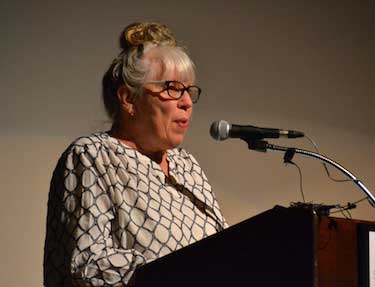
Lynn Bedford of Chautauqua County said living near wind turbines “is a form of torture.”
Lynn Bedford has seven 500-foot-tall turbines near her home in Arkwright Hills, Chautauqua County. EDP Renewables of North America started operating the 78.4 megawatt wind energy project in Arkwright, which is near Fredonia, last year.
Bedford said one of the turbines is within 1,000 feet of her home. EDP has 36 turbine sin Arkwright and they became operational last September.
“Within 24 hours my ears began to ring, it hasn’t stopped,” Bedford said. “It has affected my sleep habits. I became a victim of an uncontrollable circumstance.”
Bedford said she has become an emotional roller-coaster since the project started. She also has begun to lose vision in an eye and her heart pounds.
“The sleep deprivation has been the worst,” she said at the forum. “Some days I feel like I’m going to lose my mind. My human body is being attacked by something called infrasound. Infrasound is a weapon of war.”
Bedford has 29 grandchildren and five great-grandchildren. She is determined to fight the wind turbine project.
“In Arkwright it’s a form of torture,” she said about living by turbines. “This is actually a crime against humanity. Something must be done about it. I pray someone will put an end to this wind turbine nightmare.”

Dan Stapleton, Niagara County Commissioner of Health, has concerns with large-scale wind turbines.
Dan Stapleton, the Niagara County Commissioner of Health, also is president of a statewide association of health officials (New York State Association of County Health Officials) and a member of the Western New York Health Alliance. Those groups have all passed formal resolutions seeking for full environmental impact studies with turbine projects, including the impacts on human health.
“I don’t call them wind farms,” Stapleton said. “I call them industrial wind turbines.”
He said he and health officials aren’t against renewable energy projects, they just want detailed health impact studies.
“It shouldn’t be incumbent on the residents to prove it’s unsafe,” he said. “It should be incumbent on the developers to prove it is safe.”
The Health Department works every day with people suffering from chronic disease. Stapleton said sleep deprivation – either not enough sleep or not enough quality sleep – has an impact on human health.
“We’re talking about a large-scale project,” he said. “It is imperative to fully research and assess health implications that could put residents at risk from large industrial wind turbines.”
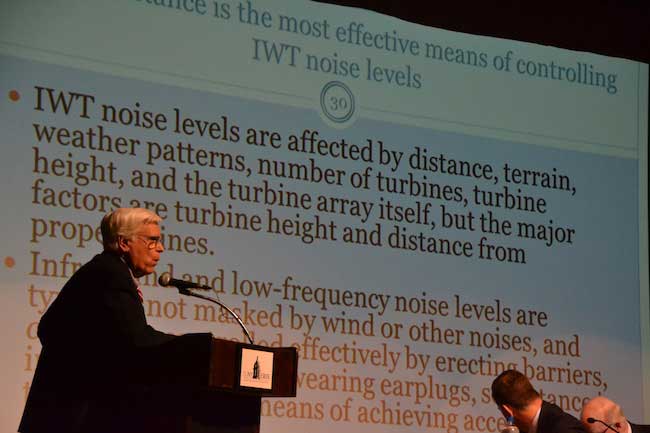
Dr. Jerry Punch, an audiologist, said turbine noise is more harmful to some people than hearing aircraft and rail traffic.
Jerry Punch, Ph.D., has worked as an audiologist for more than 50 years. He said about 10 percent of the population near large-scale wind turbines will suffer “annoyance” and sleep disruption from turbine noise.
The low-frequency infrasound can’t be heard, but it is felt by about 10 percent of the population near turbines, he said.
For them, the infrasound can be debilitating. He has met families in Michigan who had to leave their homes at night to sleep in motels. One family who fled their homes had turbines within 1,300 to 2,000 feet of their house.
Wind turbine noise has unique characteristics, he said.
“What we can’t hear can hurt us,” he said. “Infrasound is below threshold of audibility. Even though you can’t hear it can be perceived.”
The turbines are more operational at night-time, when it is quieter in a house. And turbines tend to be sited in quiet, rural areas.
Some people will suffer migraines, reduced quality of life, vomiting, extreme headaches, and changes in heart rate, he said.
He advocates for bigger setbacks. Some communities only account for the size of the turbines and blade throw, if a blade broke off. But Punch said the noise impacts need to be considered, with the turbines pushed farther away from people.
He said some experts suggest minimum distances of 0.5 to 2.5 miles, while many researchers suggest minimum of 1.25 miles.
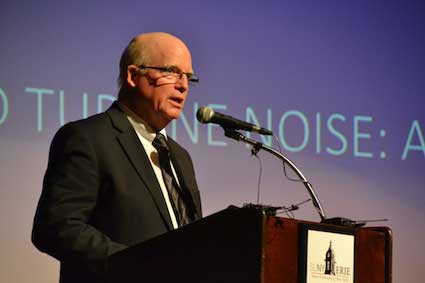
Robert Rand said people suffering from wind turbine noise shouldn’t be discounted.
Robert Rand, owner of Rand Acoustics in Maine, has worked as a noise consultant for nearly 40 years. He visited a wind turbine project and suffered with headaches and poor balance for seven weeks after that.
“I’m in that 10 percent of the population that is immediately susceptible,” Rand said. “I could not live near a wind farm.”
He said there is an impression that turbines don’t make noise, but they do, and that noise is difficult for some people to bear.
The turbines have a pulsating low-frequency noise. It isn’t steady. About every second the turbines will have a leak noise noise while the blades are spinning. That pulsating can trigger a feeling like motion sickness for some people, Rand said.
“Distance is the only reliable noise control option,” he said. “In most places there isn’t enough distance to avoid impacts.”
The noise can feel like a “thumping” at nighttime, disturbing sleep for some residents, he said.
“There is some suggestion that people are making this up,” Rand said. “I can tell you from my direct experience people aren’t making this up.”
Rand said he is concerned as developers propose larger turbines topping 600 feet in what are very quiet, rural areas.
“As they’ve gotten larger the problem has gotten exacerbated,” Rand said. “It’s gotten worst.”
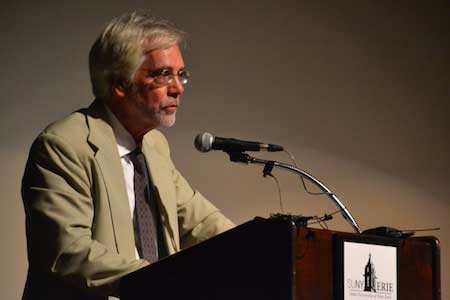
Gary Abraham, an environmental attorney, urges towns to pass wind energy laws that protect the health of residents.
Gary Abraham, an environmental attorney, has worked with municipalities to draft local ordinances with setbacks to better protect residents from noise, shadow flicker and other intrusiveness negative effects from turbines.
Although the state has created a Siting Board to review energy projects with more than 25 megawatts, Abraham said local ordinances still are considered in siting projects.
He said noise is a big impact from turbines, especially with the pulsations every second when the turbines are spinning.
He wants the Siting Board to consider the noise impacts at night.
“It’s not a constant hum,” he said. “You’re getting a noise event every second with the pulsations from wind turbines.”




































































